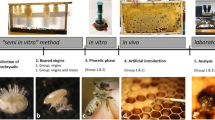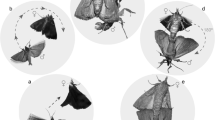Abstract
For the reproductive success of the honeybee mite Varroa destructor, an effective coordination of host finding, oogenesis, and mating is crucial. In order to analyze the mites’ mating behavior and the involved cues, a new bioassay was designed and the male behavior towards different female stages compared. This bioassay represents a simple tool for behavioral observations of V. destructor in the laboratory, showing that males almost exclusively mated with freshly molted females and that older females were rather unattractive for them. Furthermore, we could show that the highest attractiveness of female mites is limited to a short time period of about 24 h immediately after the adult molt. Our results confirm a selective pressure on effective timing and sequence of the mating behavior, and might provide possibilities for biological Varroa control.





Similar content being viewed by others
References
Boot, W.J., Calis, J.N.M., Beetsma, J. (1992) Differential periods of Varroa mite invasion into worker and drone cells of honey bees. Exp. Appl. Acarol. 16, 295–301
De Jong, D., De Jong, P.H., Goncalves, L.S. (1982) Weight loss and other damage to developing worker honeybees from infestation with V. jacobsoni. J. Apic. Res 21, 165–216
De Miranda, J., Genersch, E. (2010) Deformed wing virus. J. Invertebr. Pathol. 103, 48–61
Donzé, G., Guerin, P.M. (1994) Behavioral attributes and parental care of Varroa mites parasitizing honeybee brood. Behav. Ecol. Sociobiol. 34, 305–319
Donzé, G., Herrmann, M., Bachofen, B., Guerin, P.M. (1996) Effect of mating frequency and brood cell infestation rate on the reproductive success of the honeybee parasite Varroa jacobsoni. Ecol. Entomol. 21, 17–26
Evans, G.O. (1992) Principles of Acarology, p. 563. C.A.B. International, Wallingford
Fahle N., Rosenkranz P. (2005) Mate choice in Varroa destructor: male mites prefer young females, In: IUSSI-Proceedings of the German Section Meeting at Halle, ISBN 3-901864-02-4.
Garrido, C., Rosenkranz, P. (2003) The reproductive program of female Varroa destructor mites is triggered by its host, Apis mellifera. Exp. Appl. Acarol. 31, 269–273
Genersch, E. (2010) Honey bee pathology: current threats to honey bees and beekeeping. Appl. Microbiol. Biotechnol. 87, 87–97
Genersch, E., von der Ohe, W., Kaatz, H., Schroeder, A., Otten, C., Büchler, R., Berg, S., Ritter, W., Muehlen, W., Gisder, S., Meixner, M., Liebig, G., Rosenkranz, P. (2010) The German bee monitoring project: a long term study to understand periodically high winter losses of honey bee colonies. Apidologie 41, 332–352
Ifantidis, M.D. (1983) Ontogenesis of the mite Varroa jacobsoni in worker and drone honey bee brood cells. J. Apic. Res. 22, 200–206
Ifantidis M.D. (1990) Re-examination of some parameters concerning reproduction of the mite Varroa jacobsoni Oud. In: Proceedings of the International Symposium on Resent Research on Bee Pathology, Gent, Belgium, pp. 20–26
Ifantidis, M.D. (1988) Some aspects of the process of Varroa jacobsoni mite entrance into honeybee Apis mellifera brood cells. Apidologie 19, 387–396
Ifantidis, M.D., Rosenkranz, P. (1988) Reproduktion der Bienenmilbe Varroa jacobsoni (Acarina: Varroidae). Entomol. Gen. 14, 111–122
Laurent, J.C., Santas, L. (1987) Etude du development larvaire de Varroa jacobsoni Oud. Apidologie 18, 53–60
Martin, S.J. (1994) Ontogenesis of the mite Varroa jacobsoni Oud. in worker brood of the honeybee Apis mellifera L. under natural conditions. Exp. Appl. Acarol. 18, 87–100
Rehm, S.M., Ritter, W. (1989) Sequence of the sexes in the offspring of Varroa jacobsoni and resulting consequences for the calculation of the developmental period. Apidologie 20, 339–343
Richards, E.H., Jones, B., Bowman, A. (2011) Salivary secretions from the honeybee mite, Varroa destructor: effects on insect haemocytes and preliminary biochemical characterization. Parasitology 138, 602–608
Rosenkranz, P., Aumeier, P., Ziegelmann, B. (2010) Biology and control of Varroa destructor. J. Invertebr. Pathol. 103, 96–119
Schatton-Gadelmayer, K., Engels, W. (1988) Blood proteins and body weight of newly-emerged worker honeybees with different levels of parasitization of brood mites. Entomol. Gener. 14, 93–101
Schneider, P., Drescher, W. (1987) Einfluss der Parasitierung durch die Milbe Varroa jacobsoni aus das Schlupfgewicht, die Gewichtsentwicklung, die Entwicklung der Hypopharynxdrüsen und die Lebensdauer von Apis mellifera. Apidologie 18, 101–106
Steiner, J., Dittmann, F., Rosenkranz, P., Engels, W. (1994) The first gonocycle of the parasitic mite (Varroa jacobsoni) in relation to preimaginal development of its host, the honey bee (Apis mellifera carnica). Invertebr. Rep. Develop. 25, 175–183
Yang, X., Cox-Foster, D. (2007) Effects of parasitization by Varroa destructor on survivorship and physiological traits of Apis mellifera in correlation with viral incidence and microbial challenge. Parasitology 134, 405–412
Weller, S. (2008) Populationsdynamik der parasitischen Bienenmilbe Varroa destructor in vorselektierten Bienenvölkern (A. mellifera L.) unter besonderer Berücksichtigung der Reproduktion, Master Thesis at the Faculty of Biology at the University of Hohenheim.
Acknowledgments
We thank the Montagu Foundation and the Agroscope Liebefeld-Posieux for providing financial support. We are grateful to Barbara Locke for critical reading of the manuscript. Last but not least, we express our cordial thanks to Helen Kilian-Rosenkranz for the drawings in Figure 2.
Author information
Authors and Affiliations
Corresponding author
Additional information
Le comportement d’accouplement de Varroa destructor est déclenché par une phéromone sexuelle de la femelle. Partie 1: Comportement préférentiel des acariens mâles dans un essai biologique en laboratoire
Varroa destructor /comportement d’accouplement/comportement sexuel/mâle/ acarien/observation en laboratoire
Das Paarungsverhalten von Varroa destructor wird durch ein weibliches Sexualpheromon gesteuert. Teil 1: Präferenzverhalten der männlichen Milben in einem Labor-Biotest
Varroa destructor / Paarungsverhalten / Honigbiene/Biotest
Manuscript editor: Yves Le Conte
Electronic supplementary material
Below is the link to the electronic supplementary material.
ESM 1
(DOCX 10 kb)
Rights and permissions
About this article
Cite this article
Ziegelmann, B., Lindenmayer, A., Steidle, J. et al. The mating behavior of Varroa destructor is triggered by a female sex pheromone. Apidologie 44, 314–323 (2013). https://doi.org/10.1007/s13592-012-0182-5
Received:
Revised:
Accepted:
Published:
Issue Date:
DOI: https://doi.org/10.1007/s13592-012-0182-5




